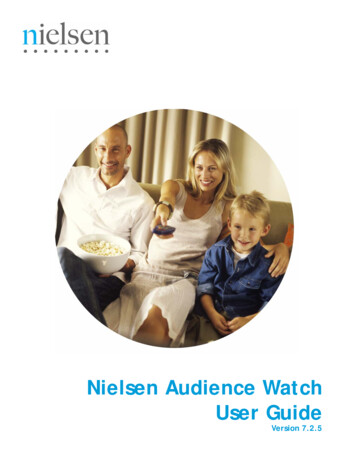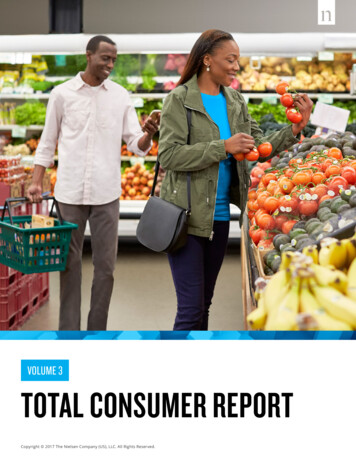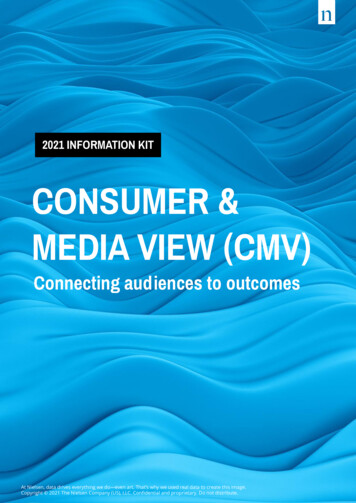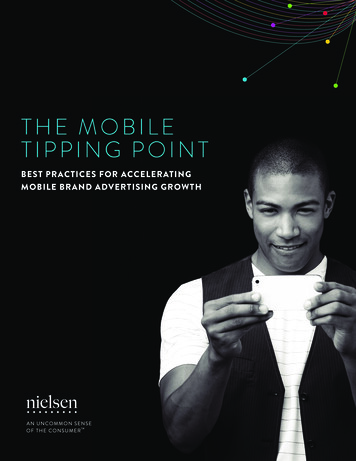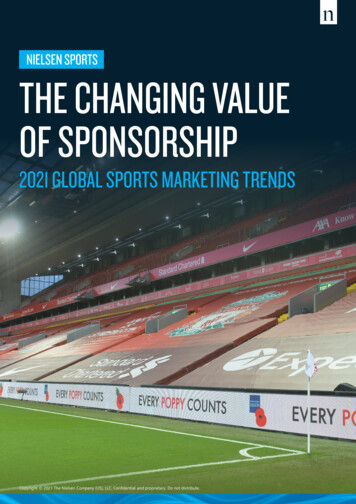
Transcription
Copyright 2020 The Nielsen Company (US), LLC. Confidential and proprietary. Do not distribute.Copyright 2021 The Nielsen Company (US), LLC. Confidential and proprietary. Do not distribute.
A disrupted world is changing the value of sponsorship. The uncertainty of the COVID-19pandemic has accelerated shifts in the way rights holders sell sponsorship, brands makesponsorship investments and how commercial partnerships are activated. Evolutions in theway fans work, travel, communicate, spend and socialize, fueled by advancing technology andconnectivity, are informing and shaping the sports sponsorship market in 2021 and beyond.New sponsorship entrants, new channels and new fan necessities are key drivers that willimpact the value of sponsorship. The identification and measurement of these drivers areessential to unlocking growth for the global sports marketing industry.Copyright 2020 The Nielsen Company (US), LLC. Confidential and proprietary. Do not distribute.Copyright 2021 The Nielsen Company (US), LLC. Confidential and proprietary. Do not distribute.2
Global economies arerecovering at differentpaces with catalyzingconsumer habits.Expect China to take anincreasingly prominent role inthe sponsorship landscape andnew/renewed categories tobecome more frequent, withtotal reach continuing to be akey component of sponsorshipvalue.Major movements aregrowing in prominenceand social attitudes arechanging.Brands are refocusingefforts on purpose-drivensponsorship strategies, whileathletes are setting the agendathrough effectivecommunications, leading tochanges in how brand equity,media reach and engagementare tracked.The rollout of COVID-19vaccines will see the gradualreturn of mass gatherings atlive events.New and innovative touchpoints to connect with fansremotely will continue to grow,leading to a wider range of fanexperiences and engagementsthat will need to be measuredwithin and against traditionalexperiences to size the impact onsponsorship value.Media consumption habitsare changing as we spendmore time at home and onmobile.Digital channels, rangingfrom streaming platforms tosocial media, are increasingtheir share within the sportsmedia mix, requiringconsistent metrics andmethodologies to measuresponsorship value across allmedia types.A global financial outlookthat remains uncertainmeans increased scrutiny ofbusiness investments.Expect sales to be anessential and measurable driverof future sports partnerships inboth the short and longer term.Copyright 2021 The Nielsen Company (US), LLC. Confidential and proprietary. Do not distribute.3
Copyright 2020 The Nielsen Company (US), LLC. Confidential and proprietary. Do not distribute.Copyright 2021 The Nielsen Company (US), LLC. Confidential and proprietary. Do not distribute.4
Brands are pivoting, adapting and recalibrating businessand marketing models to meet the changing needs ofconsumers. The sponsorship market is evolving as aresult.Traditional sponsorship categories are shifting asproducts and services change. Some consumer habitswill remain beyond the pandemic, and new andrenewed categories will take the stage.While governments attempt to resolve the pandemicwith vaccines being deployed in many countries, globaleconomies will recover at very different paces.According to the World Bank in January, China’seconomy is expected to expand by 7.9% this year,following 2% growth in 2020, the fastest and largestexpansion globally. By contrast, U.S. gross domesticproduct is forecast to see a 0.1% contraction and theEuro area a 3.8% contraction over the same two-yearperiod. This will impact sponsorship investments –globally and locally - and their origins.The role of esports within the sports sponsorshipoffering is another unsurprising evolution. There wassignificant claimed growth in esports viewership in 2020,with 16% of global respondents in Nielsen’s Esports FanInsights Report indicating they were watching morecompetitive esports events. There is also increasedinterest in playing video and mobile games. Esportssponsorship revenue has been increasing rapidly foryears - growing at a compound annual growth rate(CAGR) of nearly 32% between 2014 and 2019; furthergrowth is anticipated.Over the next 10 years, Chinese brands will beresponsible for one-third of all growth in theglobal sponsorship market. As part of a journeythat began with the Beijing Olympics in 2008,Chinese companies are increasingly using sportssponsorship as a platform to support the growthof their brands.Between 2015 and 2019, sponsorship spend ofChina-based brands rose at a CAGR of 8.9% far outpacing rivals in Europe and the U.S. Withits sponsorship of the 2018 FIFA World Cup,white goods and electronics manufacturer,Hisense, significantly increased its sponsorshipspend, while technology company Vivo, sponsorof FIFA, UEFA EURO 2020 and EURO 2024, alsosaw growth.As these brands will primarily be using sponsorshipand sports platforms to enter new markets, mediareach and fan awareness will be primary drivers ofvalue - although measured holistically across thedifferent touchpoints to engage fans.Source: Nielsen Sports Sponsorglobe AnalysisCopyright 2021 The Nielsen Company (US), LLC. Confidential and proprietary. Do not distribute.5
As consumer behaviors shift away from traditionalbanking models, the established financial servicessponsorship sector will see the emergence ofnontraditional business models. Additionally, newcategories will continue to grow as investments indisruptive business models skyrocket. Airbnb hasalready challenged the traditional sponsorship model,creating a purpose-driven sponsorship - pushingsustainability and supporting Olympic athletes - whileavoiding the traditional media play. of global financialservicessponsorship spendwill comefrom Source: Nielsen Sports Sponsorglobe AnalysisFor categories like fashion and clothing, the move fromphysical to digital could shape the future ofsponsorships. With the pandemic accelerating the shiftfrom physical stores to digital shopping by fiveyears, expect to see a rush of established retail brandsactivating their sponsorship properties using their ecommerce channels in the near future.Source: IBM US Retail Index 842M 347M2025PREPOSTEsports are an effective way to connect with new andyounger audiences while being well-placed to solveone of the major challenges of the pandemic with inperson events cancelled. This makes esports even moreattractive to brands lookingfor robust sponsorship platforms andto rights holders in traditional sportslooking to unlock brand marketing spend.Source: Nielsen Sports AnalysisNew categories and new brands entering the sponsorship market are ultimately looking for methods to target thesports audience. While the fundamental metrics of audience reach and brand awareness will continue to be part ofsponsorship performance KPIs, they must be assessed and measured in the new media reality. Measurement ofthose metrics across sponsorship campaigns, on mobile, through online videos, on social platforms like TikTok andFacebook, and direct-to-consumer (DTC) platforms created by rights holders, will have to be integrated intotraditional frameworks.For brands targeting the internet-born generation as well as the internet-adapted generation, consistentmeasurement of all these platforms with the ability to compare cross-media will be the key driver of sponsorshipvalue growth.Copyright 2021 The Nielsen Company (US), LLC. Confidential and proprietary. Do not distribute.6
Copyright 2020 The Nielsen Company (US), LLC. Confidential and proprietary. Do not distribute.Copyright 2021 The Nielsen Company (US), LLC. Confidential and proprietary. Do not distribute.7
A divided, tribal world, the rise of populism, inequality and achanging global environment have resulted in a range of political,social and charitable causes coming to the forefront and gatheringmomentum over the past year. These campaigns, movements, acts ofsolidarity and protests have been accelerated and fueled by socialmedia.Brands are reacting with new marketing approaches, wheresponsorship objectives polarize toward purpose and communitybenefits. Of the top 20 global sponsorship brands by spend in 2019,the vast majority have made an active shift in their sponsorship andadvertising messaging over the past five years.However, it is athletes more than sports organizations who aresetting the agenda and feeling increasingly empowered to promote,highlight and campaign on social issues and causes close to theirheart. Athletes such as Naomi Osaka, LeBron James, Lewis Hamiltonand Marcus Rashford, plus many others, have proved adept at usingtheir own increasingly powerful platforms to make their feelingsknown, shine a light on injustices, galvanize large audiences andinfluence decision-making.These causes and issues are resonating with fans and followers - inparticular, a younger demographic - and spurring them into action.Half of the younger population globally say they have a greaterinterest in brands that act in a socially responsible way.Source: Nielsen Fan Insights, Nielsen Sports Sponsorglobe AnalysisCopyright 2021 The Nielsen Company (US), LLC. Confidential and proprietary. Do not distribute.8
Brands are increasingly seeking rightsholders that can provide them with aplatform to promote their ownvalues, such as sustainability.Source: Nielsen Sports AnalysisSource: Nielsen Sports Digital Analysis 1.2Bx4 80% 314M 174M20192020Athletes posted more about social causes in 2020than in 2019, becoming increasingly important andinfluential in highlighting or amplifying campaignsor social injustice.202395% of athletes with more than 5 million followerson Instagram advocated for causes on social mediain 2020, collectively generating 314 million worth ofQI* media value. This underlines the potentialbenefits for brands who partner with athletesprepared to take a stand or voice their opinion on acause that resonates with fans. The series of majorglobal events in the calendar over the next twoyears, including the Olympic Games and FIFA WorldCup, are platforms upon which athletes can protestor highlight causes.Source: Nielsen Sports Digital AnalysisAthletes are now offering purpose-driven sponsorship platforms that can be integrated as a measurable monetarycomponent within the sports marketing mix. The ability of athletes to influence the sports audience will have animpact on brand equity-building objectives. This impact must be measured with holistic and consistent metrics, tocalculate the sponsorship value in both the short and long term. The number of fans reached and engaged oncebrand content has been adapted to the athletes’ communication approach will be an integral part of sponsorshipvalue.* QI Quality Indexed (media value). Nielsen Sports calculates an adjusted media equivalency that accounts for the ambient nature of sponsor led exposure. The qualityof each exposure is calculated by the QI Score and is applied to the 100% Media Equivalency.Copyright 2021 The Nielsen Company (US), LLC. Confidential and proprietary. Do not distribute.9
Copyright 2020 The Nielsen Company (US), LLC. Confidential and proprietary. Do not distribute.Copyright 2021 The Nielsen Company (US), LLC. Confidential and proprietary. Do not distribute.10
Consumers were spending more time online while utilizing multiple devices prior to the pandemic, but theenforced COVID-19 lockdowns in many countries accelerated this trend. In the U.K., time per day spent onlineamongst adults rose from 3 hours 11 minutes in September 2018 to 3 hours 29 minutes in September 2019, thento 4 hours 2 minutes during lockdown in April 2020 (Source: Ofcom).As a result, in the ongoing battle for eyeballs and attention, digital or nonlinear TV channels have grown inprominence as part of the media - and therefore marketing - mix. Even as live sports TV viewership picks upglobally following the return of leagues and events, media continues to fragment. As of Q2 2020, streaming nowcomprises one-quarter of all TV minutes viewed in the U.S. among streaming-capable households (Source: Nielsen TotalAudience Report).The growth of social media and streaming platforms has solidified their role as marketing channels, with the abilityto deliver ancillary content for rights holders and their partner brands, through behind-the-scenes documentariesand original films. This type of non-live content, for example Netflix’s F1 series Drive to Survive and Amazon’svarious All or Nothing documentaries, now forms an increasingly important element of a rights holder’s fanacquisition strategy.2018/1942%2019/20Across the top 5 U.S. digital sports platforms,11 million more people in the 25-54 age bracketwere consuming content in September 2020compared with September 2019, a reflection ofboth the fragmentation of the media market andthe accelerating growth of digital platforms.Source: Nielsen Digital Content Ratings68%This change is indicative of the greater timespent online, the growing familiarity of digitalplatforms amongst fans and the way in whichteams are investing more than ever in highlyproduced, bespoke content across these digitalchannels.Source: Nielsen Sports Social ValuationCopyright 2021 The Nielsen Company (US), LLC. Confidential and proprietary. Do not distribute.11
98%66%50%TV - averageTottenham Hotspur’s “All orNothing” documentary serieshas not only provided a newlens through which fans canwatch their team, it is havinga positive impact on feelingstowards the club - for examplein the U.K. and U.S. 34%Social - 2222-2323-24The average social media value for the top eight NBA teams couldovertake TV media value by the 2023/24 season. When looking at theEnglish Premier League, the average share of social value versus TV is24%, increasing from below 5% in 2015. Increased engagement andfurther investment in content is resulting in new and enhanced partnerassets, notably through branded content, all of which can be properlymeasured and can generate significant return on sponsorshipinvestment.Source: Nielsen Fan InsightsSource: Nielsen Sports Social Valuation, Sport24Sponsorship value is increasingly driven by digital channels, including OTT services. These services may not yet beproviding significant subscription revenues for rights holders but are effective marketing tools for sponsors and acontributor to the overall sponsorship value. The use of streaming platforms, social media, mobile devices andother technologies has reached a “materialization.” As these platforms continue to grow, their role in sponsorshipagreements and assets creation will become more prominent.Given the number of different channels, increasing consumption and the various combinations ofbrands/platforms/target audience/content, a unifying measurement system is needed. This will ensure value grows,help de-risk sponsorship investments and result in more sustainable sponsorship strategies.Copyright 2021 The Nielsen Company (US), LLC. Confidential and proprietary. Do not distribute.12
Copyright 2020 The Nielsen Company (US), LLC. Confidential and proprietary. Do not distribute.Copyright 2021 The Nielsen Company (US), LLC. Confidential and proprietary. Do not distribute.13
A successful rollout of COVID-19 vaccines will ultimately see thereturn of mass gatherings at live events. However, a return tocapacity crowds at venues will be a gradual process, and there willbe some permanent changes to large-scale events, as newtechnology solutions, hygiene protocols and crowd behaviors areintroduced.Rights holders and brands will continue to develop the type ofvirtual and digital solutions rushed into action during the initialoutbreak of the virus in 2020. Live and virtual will merge, openingnew opportunities for fan connections, personalized experiences,reimagined sponsorship assets and even new sponsorship revenuemodels.For fans at home, the picture will change too. Several of theinnovations introduced into broadcasts when the pandemicrendered stadiums empty will remain, with further investment innew broadcast technologies anticipated to be up 67% (Source: IABM).According to Nielsen Fan Insights, over half of fans say they aremore likely to consider brands that are actively enhancing the waylive sport is viewed. This includes the kind of technology and datavisualization solutions offered by the likes of Microsoft and AmazonWeb Services. Hospitality offerings, meanwhile, will evolve as virtualexperiences.Copyright 2021 The Nielsen Company (US), LLC. Confidential and proprietary. Do not distribute.14
With stadiums empty, newsponsorship inventory wascreated at the start of thepandemic and generatedaroundgenerated pergame throughfor sponsors during the2020 regular season for theaverage NFL team.for sponsors of PremierLeague clubs last season.generated from Microsoft’sduring the summer of 2020 in the bubble.Many existing rights holder and brandpartnerships have been reevaluated, especiallythose involving a technology component. Newsolutions to enhance the at-home fanexperience and drive additional value forbrands will continue to emerge.Source: Nielsen Sports Media Valuation, Sport24Copyright 2021 The Nielsen Company (US), LLC. Confidential and proprietary. Do not distribute.15
With the vaccine program rolling outglobally at different speeds aroundthe world, leading to longer-lastingimpact on spectator sports, future value growth will begenerated by delivering engaging content, available tofans virtually.Cycling’s Milano-SanremoVirtual Experience and theSpartan Race obstacle course series are just acouple of examples of successful virtual eventsthat are now leveraging various digitalplatforms. A major focus on providing virtualhospitality will be developed, following the leadof major rights holders like F1 and Extreme E.Source: Nielsen Fan InsightsCOVID-19 has accelerated the adoption of technologies aimed at creating unique experiences for fans. With virtualevents continually being developed and refined, there will be an increase of fan touchpoints and thus an increasein the complexity of the fan journey. Engagement and participation of fans in these new hybrid experiences willbecome dominant sponsorship metrics. The quality of fan interactions as well as eyeballs will become even moreimportant with the objective of identifying the most valuable stages of the fan journey and enabling tangibleoutcomes for sponsors, specifically tied to sales.Copyright 2021 The Nielsen Company (US), LLC. Confidential and proprietary. Do not distribute.16
Copyright 2020 The Nielsen Company (US), LLC. Confidential and proprietary. Do not distribute.Copyright 2021 The Nielsen Company (US), LLC. Confidential and proprietary. Do not distribute.17
COVID-19 continues to affect the global economy anddominate government investment decisions andpriorities across the world. Amid the continuinguncertainty, many brands, particularly those in theWest, are facing cuts to marketing budgets. Researchorganization WARC projected that global advertisingspend in 2020 would fall by 8.1% - some 49.6 billion- to 563 billion (Source: WARC Global Advertising TrendsReport).Across product categories, advertising spend issignificantly down: travel and tourism (-31%), leisureand entertainment (-29%) and financial services(-18%) are among the sectors hit hardest.Inevitably, the decrease in advertising spend has aknock-on effect for sponsorship and rights holderrevenue streams. As a result, several new andinnovative models of sponsorship are being evaluatedand trialed.Examples include performance-related deals, shortterm agreements, sponsorships split by distributionchannel and the bundling of assets and properties.Their effectiveness, however, remains unproven andno single model for the future has emerged thus far.Under pressure to justify decisions aroundsponsorship and activation, and with e-commercebecoming more relevant for B2C brands (as indicatedin the first trend), brands are demanding more clarityon ROI, underlining the need for a sophisticated androbust measurement framework that is able todirectly link sponsorship investment to salesgenerated. Proving sponsorship’s contribution tosales, both in the short and longer term, is nowessential for any brand engaging in a partnership, orrights holder selling sponsorship.When I look at any sponsorship deal, I always have these two lenses: is it building valuefor the brand and the business in the long term? Is it driving sales in the short term? Someof them do better in one side than the other, but [sponsorship investments] always have tohave both components and brands that are overlooking one or the other are missing anopportunity. It’s not an easy discipline [to ensure short-term and long-term targets aremet] because tools [to be able to measure the results] have to be developed, but it’sabsolutely doable.Former Head of Global Sponsorshipat the Coca-Cola CompanyCopyright 2021 The Nielsen Company (US), LLC. Confidential and proprietary. Do not distribute.18
Across Nielsen clients, on average 15% of brand marketingbudgets is allocated to sponsorship but is often not measuredin relation to direct sales. This means a brand’s full marketingimpact is not being determined. Although there is increasingpressure to justify decisions around sponsorship andactivation investments, many brands are still using basic andinefficient measurement frameworks.First 6 MonthsAfter 6 monthsMeasuring sponsorship with theappropriate metrics linked to salesimpact and doing so in contextwith other marketing activities cangenerate up to a 20% increase inROI. Through enhancedmeasurement, this ability to provesponsorship’s contribution to salesboth in the short and longer termis now an essential asset for anybrand engaging in a partnership, orrights holder selling sponsorship.53%47%Longer-term sales impact is almost always ignored and as aresult the true ROI is often significantly understated. This isespecially true in sponsorship, which tends to focus on brandrather than product-level communication, generating longterm impact.Source: Nielsen Client Base AnalysisThe value of sponsorship will be directly related to the ability of a partnership to generate sales within a brand’smarketing mix. Vanity metrics, like eyeballs or social media “likes,” will be supplemented with sales metrics,acquisition rates and retention rates. These must be measured with a standardized approach to identify thecontribution of sponsorship versus other marketing activities on short-term and long-term sales.Copyright 2021 The Nielsen Company (US), LLC. Confidential and proprietary. Do not distribute.19
This examination of how sponsorship value is changing has been compiled usingvarious Nielsen Sports insights and thousands of conversations with clients around theworld. Those discussions, across 1,700 brand and rights holder clients, haveunderpinned the increasing focus on value and the need to understand return - in full,across channels and over time - as a business necessity.Measurement needs to be holistic and adaptable:The evolution of the sponsorship industry is transforming the definition of value in acomplex and fragmented environment. New consumer behaviors, new and morechannels, new and more platforms and new and more fan experiences are creatingmultiple combinations that are responsible for driving the true value of sponsorship.As tangible outcomes are the only way to establish value, sponsorship value needs tobe assessed through a sophisticated measurement framework utilizing standard andadaptable metrics.Value comes from both brand equity and sales impact:Key metrics like cross-media impressions, brand awareness and familiarity, and actualand predicted sales within sponsorship must be measured consistently acrossplatforms and assets to understand ROI.Nielsen’s Return on Sponsorship Investment model allows keyindustry stakeholders to compare and calculate return onsponsorship, minimize brand investment risk and developincreasingly effective rights holder platforms. This allows bothbrands and rights holders to grow faster, reduce waste, and focuson creating partnership value.Copyright 2021 The Nielsen Company (US), LLC. Confidential and proprietary. Do not distribute.20
Nielsen Sports is the leading source of sports measurement and analyticsaround the world, with solutions spanning cross-platform media valuation, faninsights and digital & social analysis. With unrivaled data, products andconsulting services, Nielsen Sports is uniquely positioned to help brands,leagues, teams, federations and agencies optimize sponsorship portfolios andmaximize investments in sports. Nielsen Sports is part of Nielsen Holdings plc(NYSE:NLSN), an S&P 500 company with operations in over 100 countries,covering more than 90% of the world’s population.For more information, visit:www.nielsensports.comCopyright 2021 The Nielsen Company (US), LLC. Confidential and proprietary. Do not distribute.21
global sponsorship market. As part of a journey that began with the Beijing Olympics in 2008, Chinese companies are increasingly using sports sponsorship as a platform to support the growth of their brands. Between 2015 and 2019, sponsorship spend of China-based brands rose at a CAGR of 8.9% - far outpacing rivals in Europe and the U.S. With



